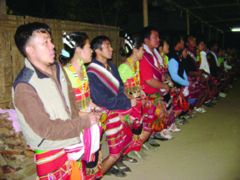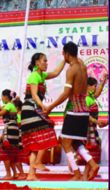Gaan Ngai festival in Manipur

There’s no denying the fact that Manipur has a cycle of festivals as the state is the birth place of over 33 ethnic communities. With the setting of winter in the state came the start of a series of traditional festivals beginning with the enchanted Kut festival of the kuki-chin-mizo communities on the first day of November every year. Now it’s the turn of Zeliangrong communities comprising the Zemei, Liangmei and the Rongmei tribes which are said to be brothers originating from a common ancestor to celebrate the Gaan-Ngai festival which begins from the 13th day of Wakching; a Manipuri month which falls between December-January every year. Interestingly Zemei, Liangmei and the Rongmei have their own names of their festival. The Zemei call it Hega Ngi, the Liangmei call it Chaga Ngi or Chaga Ngai and the Rongmei call it Gaan Ngai. ‘Gaan’ means ‘month’ and ‘Ngai’ means ‘festival’ in the Rongmei dialect. 
This is a festival during which those who died in the previous year are given a ritual farewell or departure; their graves are beautified, dances are performed in their honor, a feast is given to the community in honor and of the dead.Thus this is a festival of both the dead and the living.
According to an article by eminent scholar Prof Gangmumei Kamei, the Puimei, another cognate group also performs the same festivals of the Zeliangrong. Gaan-Ngai literally means the festival of winter season (Gaan or Ganh means winter or dry season and Ngai means festival.) It is derived from the name of the winter season like Chakan Ganh, Ganbu or Enganh. This was fixed in 1947 by the erstwhile Kabui Naga Association, the progenator of the present Zeliangrong Union. The festival is celebrated from five to seven days depending on local variations. This year it falls on January 9. Thus as in the past, the Zeliangrong community settling in India’s three Northeastern states of Manipur, Assam and Nagaland were busy celebrating their post harvest festival
In Manipur, Zeliangrong pockets including those in and around Imphal valley wore a festive look as they began to celebrate their biggest post harvest festival in their respective localities or villages. With cultural gusto and religious fervour, the main state level inaugural function of the colourful festival was held under the theme of “Loss of culture is loss of identity,” at the Iboyaima Shumang Leela Complex at Hapta Kangjeibung in Manipur’s Imphal east district recently.
Manipur’s Arts and Culture Minister Pheiroijam Parijat Singh and Lok Sabha MP from outer Manipur parliamentary constituency Mani Charenamei attended the opening function as the Chief Guest and President of this year’s Gaan Ngai. In his speech Minister Parijat said this year is particularly fortunate as there will be two Gaan-Ngai festivals, one in the beginning of the year and another at the end of the year. This is because the Zeliangrongs like so many other traditional communities, follow the lunar calendar and the length of each year does not always tally with the more universal and modern solar calendar. MP Mani Cheranamei said Gaan-Ngai is important for the bond it forges not just amongst the disparate units of the larger Zeliangrong family, but also all the people of the state and region.
Other speakers also expressed their desire to have a colourful gathering of different ethnic communities settling in the state on this day as done during other traditional festivals like the majority Meitei’s biggest festival Ningol-Chakkouba of Manipur.

After the festival was declared open by the dignitaries, a series of cultural dances were performed by dancers from Chinikon village in Senapati and Toubul in Bishnupur districts during the inaugural session. Many singers from various Zeliangrong pockets in and around Imphal also turned up to present a number of folk songs during the occasion.
Also known as a festival of the worship of God and honouring of the dead, the festival began with the oblation of Holy Wine to Tingkao Ragwang (indigenous God of the Zeliangrong), chanting of Hoi or Ho-hoing (an invocation to God) and extraction of Sacred Fire, which are an inseparable part of the Gaan-Ngai. This was followed by the symbolic extraction and fetching of fire from Sangaiprou, Khangchu etc.
As rich tradition, rituals, colourful costumes, elaborate hand woven clothes and delicious home made dishes characterise the true meaning of ‘Gaan Ngai’, all the men were gather at ‘Khangchu’ (house of the men) and the women at ‘Luchu’ and took part in numerous activities in their respective villages. Children are seen wearing new clothes and playing which only adds to the festive atmosphere.
Scholars have termed the festival as a unique cultural phenomenon, a form of aesthetic expression of the Zeliangrong religion and philosophy. It is also an institution through which the community sustains their cultural heritage and way of life. Gaan-Ngai is the essence of the Zeliangrong culture.
The festival was declared a Restricted Holiday in 1976 and was upgraded to a public holiday on 10 January 1998 by the then Chief Minister of Manipur Wahengbam Nipamacha Singh. Thus the government of India has also recognized it as a tourist festival of the country as well.


